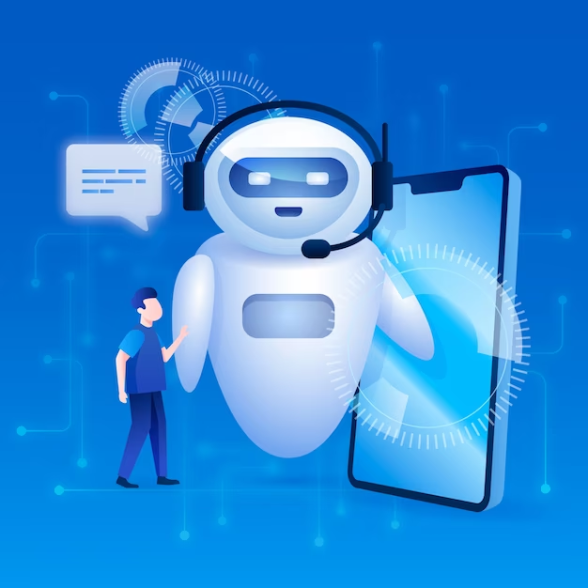- Resources
- Want a voice bot for your support or sales calls? 3 pointers to get you started
Want a voice bot for your support or sales calls? 3 pointers to get you started

In this article, we will explore:
What is a voice bot?
I would define a voice bot as an interactive voice user interface powered by NLP. It can help your inbound or outbound call center in several ways. In terms of customer support, a voice bot can be used to help provide self-service. In outbound call centers, voice bots can give dynamic, personalized reminders for payments, past dues, renewals or more.
Possible uses of voice bots for support calls:
- Provide self-help for calls waiting in the queue at your customer support center.
- Answer Frequently Asked Questions for users calling into your support center.
- Act as an auto-receptionist, guiding the caller to the right agent.
- Help cancel or reschedule bookings for customers calling into your center.
Possible uses of voice bots for sales calls:
- Schedule appointments with prospects or leads.
- Qualify leads after your dialer connects and before the agent goes live during sales calls.
- Confirm a prospects readiness/interest to talk during cold calling.
What should you be clear on before implementing your bot? Here’s my advice:
Define the problem. The most difficult, important and critical task in designing your voice bot is to define the problem. What problem do you want your voice bot to solve? Don’t just try to fit a solution into your setup for the sake of being tech savvy. Instead, think of what problems you have, and use the technology to solve the problem. For example, you could think of:
– What questions/queries can your voice bot take care of?
– What kind of information can it glean from the customer/prospect?
– What part of the agent’s conversation is repetitive?
– What part of the agent’s workflow could be made smoother/faster by using a bot?
– What processes can a bot take care of faster than a human?
-e.g, one client identified that reservations and cancellations take place faster via self-service than via agents.
Understand your caller/callee. After you define what problem your bot can solve, the next most important point to consider is your target customer. Start by asking: is my targeted customer/end-user ready for a voice bot?
Once you’ve affirmed this, figure out what number and nature of questions the customer will be willing to answer. For example, when a customer opts for self-service via a bot, they may be willing to answer a few questions, so that the bot understands their problem. When you are making a sales call, your prospect may be willing to answer only a simple, pertinent question asked by your bot. In neither case can it bother people with deep, multiple levels of questioning. It cannot be like: first, you answer 10-15 questions, then I will solve your problem! Like a well-trained agent, it should grasp the customer’s issue within 2-3 questions.How does this questioning occur? let me demonstrate with the example of someone calling our contact center regarding a problem they’re facing with their telephony software:
The first question the bot asks, figures: the issue is related to PRI problem.
The second question may determine that: it is a regional PRI problem.
The third question may find out that: it is a PRI problem, but connectivity is the main issue. This is your series of questions that helped you formulate your understanding of the customer s problem.Your answers too should be short and easily understood by your target audience. We believe that how well the questions/conversation is formatted depends a lot upon a successful understanding of your target audience.
Build Your Knowledge Base.
Let’s say, your self-service bot just pinpointed what the caller’s problem is. Maybe it took 1-4 questions to understand the problem. Now once you found the problem, comes the next obvious step: give an answer!
The bot must have built up a knowledge base. This knowledge base helps determine what the answer is, and how customized can that answer be. For example, in the self -service bot example I mentioned earlier: A bot may have understood that the problem is not with your product, but a third party. If you know the third-party contact details, that would be useful info to give a caller rather than a “please contact Mr. third party” answer. You WANT to be helpful, so keep that in mind while building your knowledge base.
Developing your Bot.
Question: Is it difficult to develop a bot?
Answer: No. Once you have gathered all the information you have to give the customer and created a series of questions to pinpoint accurately & as fast as possible what the customer wants, building the bot is easy. There are tonnes of tools such a Speech Recognition and Intent Analysis that can easily understand your customer and provide answers.
The developer will essentially create a flow, decide where to use tools such as speech recognition and intent analysis. Then add in personality, maybe using humor or designing replies, filler phrases etc. And in about 12- 20 days, you can have a voice bot created, tested and ready for action.
Summary
The critical part of developing your bot, I strongly believe, happens long before your developer starts creating the bots flow, during these three critical steps:
- Confirming that your problem and audience find it useful if you use automatic voice bot. or is it such a problem that it should not be used.
- Designing your questions in such a way that it is not tedious.
- Finding your proper knowledge base.







